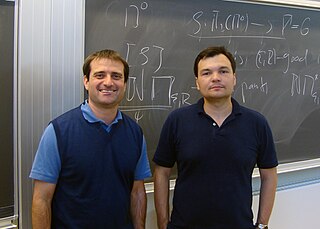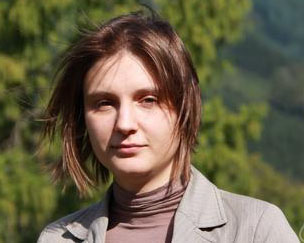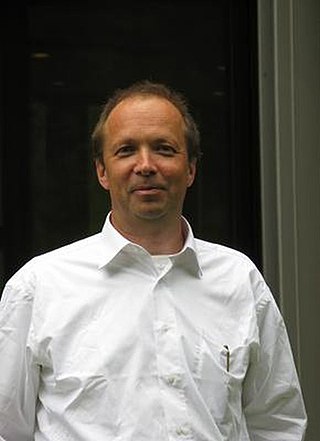Related Research Articles
In mathematics, Serre's modularity conjecture, introduced by Jean-Pierre Serre, states that an odd, irreducible, two-dimensional Galois representation over a finite field arises from a modular form. A stronger version of this conjecture specifies the weight and level of the modular form. The conjecture in the level 1 case was proved by Chandrashekhar Khare in 2005, and a proof of the full conjecture was completed jointly by Khare and Jean-Pierre Wintenberger in 2008.
In number theory, the Green–Tao theorem, proved by Ben Green and Terence Tao in 2004, states that the sequence of prime numbers contains arbitrarily long arithmetic progressions. In other words, for every natural number k, there exist arithmetic progressions of primes with k terms. The proof is an extension of Szemerédi's theorem. The problem can be traced back to investigations of Lagrange and Waring from around 1770.
In mathematics, the local Langlands conjectures, introduced by Robert Langlands, are part of the Langlands program. They describe a correspondence between the complex representations of a reductive algebraic group G over a local field F, and representations of the Langlands group of F into the L-group of G. This correspondence is not a bijection in general. The conjectures can be thought of as a generalization of local class field theory from abelian Galois groups to non-abelian Galois groups.

Michael Rapoport is an Austrian mathematician.
In mathematics, the André–Oort conjecture is a problem in Diophantine geometry, a branch of number theory, that can be seen as a non-abelian analogue of the Manin–Mumford conjecture, which is now a theorem. The conjecture concerns itself with a characterization of the Zariski closure of sets of special points in Shimura varieties. A special case of the conjecture was stated by Yves André in 1989 and a more general statement was conjectured by Frans Oort in 1995. The modern version is a natural generalization of these two conjectures.
In algebraic geometry, a Newton–Okounkov body, also called an Okounkov body, is a convex body in Euclidean space associated to a divisor on a variety. The convex geometry of a Newton–Okounkov body encodes (asymptotic) information about the geometry of the variety and the divisor. It is a large generalization of the notion of the Newton polytope of a projective toric variety.

Jeremy Adam Kahn is an American mathematician. He works on hyperbolic geometry, Riemann surfaces and complex dynamics.
In mathematics, a weak Maass form is a smooth function on the upper half plane, transforming like a modular form under the action of the modular group, being an eigenfunction of the corresponding hyperbolic Laplace operator, and having at most linear exponential growth at the cusps. If the eigenvalue of under the Laplacian is zero, then is called a harmonic weak Maass form, or briefly a harmonic Maass form.

Maryna Sergiivna Viazovska is a Ukrainian mathematician known for her work in sphere packing. She is a full professor and Chair of Number Theory at the Institute of Mathematics of the École Polytechnique Fédérale de Lausanne in Switzerland. She was awarded the Fields Medal in 2022.

Stephen S. Kudla is an American mathematician working in arithmetic geometry and automorphic forms. He is a professor in the Department of Mathematics at the University of Toronto.

Günter Harder is a German mathematician, specializing in arithmetic geometry and number theory.

Xinyi Yuan is a Chinese mathematician who is currently a professor of mathematics at Peking University working in number theory, arithmetic geometry, and automorphic forms. In particular, his work focuses on arithmetic intersection theory, algebraic dynamics, Diophantine equations and special values of L-functions.

Kevin B. Ford is an American mathematician working in analytic number theory.
Vincent Pilloni is a French mathematician, specializing in arithmetic geometry and the Langlands program.
In mathematics, the Gan–Gross–Prasad conjecture is a restriction problem in the representation theory of real or p-adic Lie groups posed by Gan Wee Teck, Benedict Gross, and Dipendra Prasad. The problem originated from a conjecture of Gross and Prasad for special orthogonal groups but was later generalized to include all four classical groups. In the cases considered, it is known that the multiplicity of the restrictions is at most one and the conjecture describes when the multiplicity is precisely one.
Shen Weixiao is a Chinese mathematician, specializing in dynamical systems.
Sug Woo Shin is a professor of mathematics at the University of California, Berkeley working in number theory, automorphic forms, and the Langlands program.
Adrian Ioviță is a Romanian-Canadian mathematician, specializing in arithmetic algebraic geometry and p-adic cohomology theories.

Sebastiaan Johan Edixhoven was a Dutch mathematician who worked in arithmetic geometry. He was a professor at University of Rennes 1 and Leiden University.
References
- ↑ "Alexanderson Award Recipients". AIM. Retrieved 2 April 2024.
- 1 2 3 Donaldson, Brianna; Farmer, David; Koutsoliotas, Sally; Manes, Michelle (24 March 2024). "AIM: Building and Supporting Collaborative Research Communities". The Mathematical Intelligencer. doi:10.1007/s00283-024-10336-3 . Retrieved 2 April 2024.
- ↑ "Alexanderson Award". AIM. Retrieved 2 April 2024.
- ↑ Borodin, Alexei; Corwin, Ivan; Ferrari, Patrik (July 2014). "Free Energy Fluctuations for Directed Polymers in Random Media in 1 + 1 Dimension". Communications on Pure and Applied Mathematics. 67 (7): 1129–1214. arXiv: 1204.1024 . doi:10.1002/cpa.21520.
- ↑ "ARCC Workshop: The Kardar-Parisi-Zhang equation and universality class". aimath.org.
- ↑ "Alexanderson Award 2019". AIM. Retrieved 2 April 2024.
- ↑ Bruillard, Paul; Ng, Siu-Hung; Rowell, Eric; Wang, Zhenghan (21 July 2015). "Rank-finiteness for modular categories". Journal of the American Mathematical Society. 29 (3): 857–881. doi:10.1090/jams/842.
- ↑ "ARCC Workshop: Classifying fusion categories". aimath.org.
- ↑ "Alexanderson Award 2020". AIM. Retrieved 2 April 2024.
- ↑ DeMarco, Laura; Krieger, Holly; Ye, Hexi (1 May 2020). "Uniform Manin-Mumford for a family of genus 2 curves". Annals of Mathematics. 191 (3). arXiv: 1901.09945 . doi:10.4007/annals.2020.191.3.5.
- ↑ "Past SQuaREs | American Inst. of Mathematics".
- ↑ "Alexanderson Award 2022". AIM. Retrieved 2 April 2024.
- ↑ Bruinier, Jan H.; Howard, Benjamin; Kudla, Stephen S.; Rapoport, Michael; Yang, Tonghai (2020). "Modularity of generating series of divisors on unitary Shimura varieties". Astérisque. 421: 7–125. arXiv: 1702.07812 . doi:10.24033/ast.1126.
- ↑ Bruinier, Jan H.; Howard, Benjamin; Kudla, Stephen S.; Rapoport, Michael; Yang, Tonghai (2020). "Modularity of generating series of divisors on unitary Shimura varieties II: arithmetic applications". Astérisque. 421: 127–186. arXiv: 1710.00628 . doi:10.24033/ast.1127.
- ↑ "Past SQuaREs | American Inst. of Mathematics".
- ↑ "Alexanderson Award 2023" (PDF). AIM. Retrieved 2 April 2024.
- ↑ Matomäki, Kaisa; Radziwiłł, Maksym; Tao, Terence; Teräväinen, Joni; Ziegler, Tamar (1 March 2023). "Higher uniformity of bounded multiplicative functions in short intervals on average". Annals of Mathematics. 197 (2). doi:10.4007/annals.2023.197.2.3.
- ↑ "ARCC Workshop: Sarnak's conjecture". aimath.org.